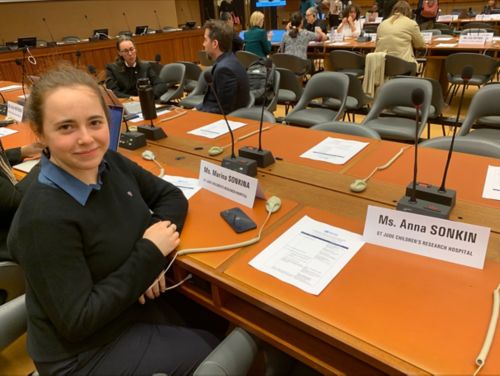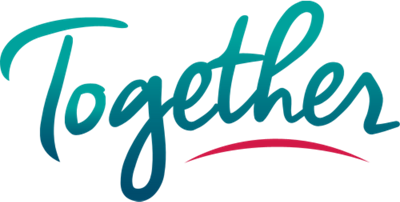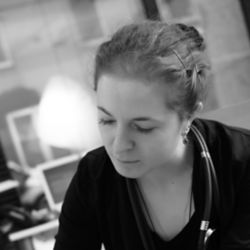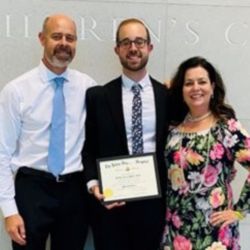Engaging Patients and Families in their Care Journey

Anna Sonkin, MD, is both a palliative care doctor and the mother of a childhood cancer survivor. She and her daughter participated in an event organized by the World Health Organization (WHO) to draft a joint statement among people affected by cancer and emergent leaders on priorities for cancer 2030.
I’m a palliative care doctor by training, but I’m also a parent of a childhood cancer survivor. My perspective is unique as I’m familiar with both sides of the patient-doctor relationship. As I wrote in my blog post “Reflections on Knowledge from a Parent-Physician,” my daughter was diagnosed with a brain tumor at age 15. At the time of her diagnosis, I did not think she could have cancer. But she did.
Going through this process with my daughter, I have learned a lot about being an advocate for my child. As a parent of a child with a serious illness, you do not have to sit back. You and your child can take part in their care and treatment. You know your child best—and you have a voice.
Your experience is valuable
Hospitals around the world are focusing on families’ lived experience and the expertise they have acquired. Care teams also encourage shared decision-making about treatment and care.
Here are some terms often used to discuss these concepts:
- Lived experience: Knowledge that a person gains from going through an illness or condition. Health care teams can work with people who have a condition to make the care and treatment process better.
- Shared decision-making: Health care teams work with patients and families to make decisions related to care.
- Patient family-centered care: Health care that considers the knowledge, values, beliefs, preferences, and cultural backgrounds of patients and families—and includes them in care decisions.
- “Nothing for us without us”: This phrase means that the decisions that affect a group of people should not be made without the input and collaboration of that group. This can refer to people living with cancer, mental health conditions, or other conditions.
- People-centered cancer care: Care that treats the patient as a whole, unique person who is part of a social community.
- Meaningful engagement movement: A movement to ensure that all patients are valued, have a sense of purpose, and are included in health care decisions.
WHO session on cancer care
Last fall, the World Health Organization (WHO) sponsored an event to create priorities to amplify the voices of people affected by cancer. I was interested in this event because I am a parent with the lived experience of childhood cancer. WHO also shared a document titled WHO Framework for Meaningful Engagement. This document supports the WHO in helping to create and enhance policies, programs, and services.
My daughter Marina and I were able to attend the WHO event in Switzerland. It was the first time Marina, now 20 years old and 5 years post-diagnosis, spoke openly about her disease.
When group members introduced themselves, the only thing Marina said was, “I am a survivor.” I could see that it was not an easy thing for her to say. She sat quietly, listened, and gave several insightful suggestions. She had never seemed so grown up to me as she did in that moment.

Marina Sonkina is the daughter of Anna Sonkin, MD. As a brain tumor survivor, she spoke about her experience with cancer at a WHO meeting in Geneva, Switzerland.
Nothing for us without us
The motto of the meaningful engagement movement is “Nothing for us without us.” This is a powerful statement that works on all levels of health care. But it does not exist in many countries, including Russia where we lived when my daughter was diagnosed.
Doctor-patient engagement
On the doctor-patient level, meaningful engagement means shared decision-making. There is evidence that when patients and families take part in clinical decision-making, it can improve the outcomes of care. Health care teams should be truly prepared to make decisions along with patients and families. My daughter would certainly have had insights if anyone had asked her when she was in treatment.
Hospital-level engagement
Engagement on the hospital level is where patients and families have the chance to give feedback, share insights, and take part in decisions about hospital life, buildings, and processes. Again, we would have had a lot to say if this chance had been offered to us during my daughter’s treatment.
Research-level engagement
Engaging patients and families on the research level is the subject people talk about the most. It is hard but necessary to include patients and families in research decisions. We cannot spend all of our resources on generating knowledge that does not address what people with lived experience see as important. Patients and families know a lot about what is important and what is not.
Government-level engagement
Government-level engagement involves making policies, planning health care, raising awareness, and providing resources. The WHO sets a high standard for meaningful engagement, including funding, training, long-term support, and ending stigma.
Patients and families should have the opportunities, skills, formal positions, and compensation to take part in government-level efforts. Global agencies should work to encourage and support countries in creating the conditions where these opportunities can happen.
This is exactly what the WHO is trying to do and why it invited us to the session. Because Marina is studying environmental economics and wants to work with governments, she had suggestions.
After the session, she told me how surprised she was that her ideas were taken seriously and were included in the statement draft.
Patients and families also must learn how to make use of their experience. I find myself on both sides of the dialogue at the same time. As someone working in global health, I sometimes do not know when to ask questions and which questions I need to ask. As a parent with lived experience, I often do not know when and what to say.
Both sides now
Engagement in the care process requires work. Clinicians, hospital leaders, researchers, governments, and global groups must understand why it is challenging. And they must find better ways to truly include patients and families.
Patients and families also must learn how to make use of their experience. I find myself on both sides of the dialogue at the same time. As someone working in global health, I sometimes do not know when to ask questions and which questions I need to ask. As a parent with lived experience, I often do not know when and what to say. Thankfully, the WHO is giving both my daughter and me a chance to learn about meaningful engagement and be part of it.
After the WHO meeting in Switzerland ended, my daughter and I bought souvenirs in the United Nations (UN) gift shop, took selfies with the flags, and had a wonderful fondue dinner. The next day we said goodbye, and Marina flew back to England. She was mentally preparing for the school year and planning to apply for an internship at the UN. She was also prepared to change the world through her meaningful lived experience.





